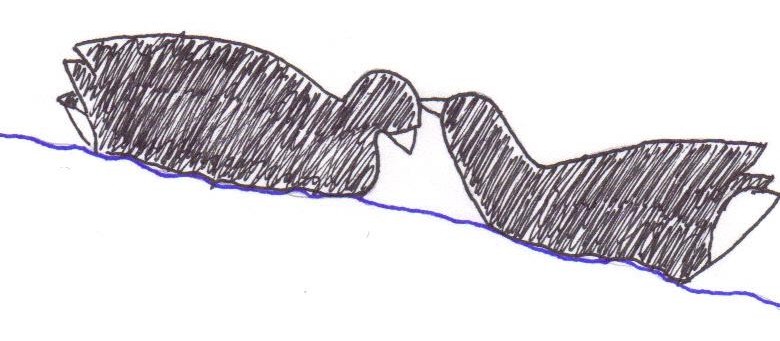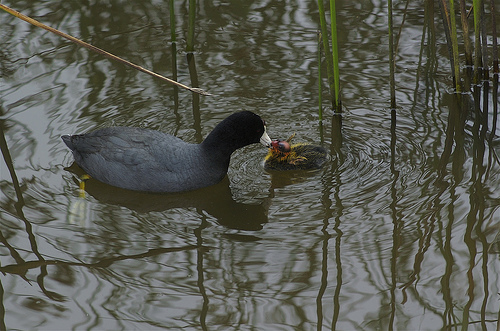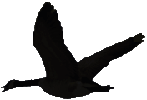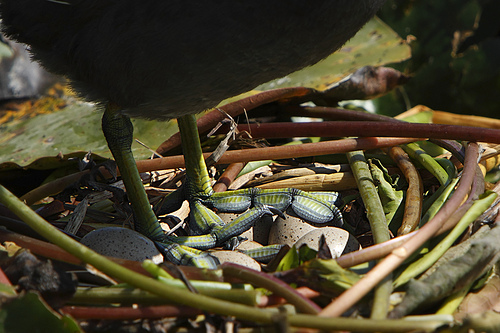Reproduction
Another necessity of life is reproduction. For the American Coot the process is pretty much the same as for most birds. Both sexes participate in mating calls and gestures, they will breed, the female will lay eggs, and both parents will take care of the young until they are ready to do so for themselves. There is an interesting evolutionary adaptation where the American Coot can tell if the egg that hatches is not their own. To learn more about this check out Interactions of the American Coot.
Reproduction starts with finding a mate. In the case of the
American Coots both the male and female coots will show off
for potential mates. One such body posture that is used is a
bowed head. This represents the basic form of courtship
displays in the search for a mate. Billing is another body
gesture used between potential mates during the search for a mate
and also for recognition of the young by the parents. Once
billing occurs, bowing is next. The obedient Coot starts by
going into a bow and presenting its head or neck to the dominant
Coot for it to begin nibbling. During the nibbling process the
dominant bird runs its beak through the feathers of the other bird.
Sometimes the beak is completely buried in the back feathers of the
other bird. Both females and males can also stand on a
platform of some kind out in the water and try to impress Coots that
swim by. All of these actions are very important in finding a
mate and courtship.

 In the search for a mate both sexes of Coots will also make calls
to attract members of the opposite sex. Males are mostly
limited to a cough sounding call. If during a chase where the
male is chasing the female and the female does not want to
participate in mating activity with that male she will stop flying,
turn to face him and deliver a "tack, tack" call. That call
stops the chase and both Coots continue doing what they were doing
before the chase. The female has a nicer sounding call than
the male. When the female is on a platform looking for a mate
she will make low, nasal sounding "punt, punt" or "put, put" calls
or a sharper, clearer "tuk, tuk" call. Also while in
the pursuit for a mate the Coots will splash around in the water and
make chirping type calls to each other.
In the search for a mate both sexes of Coots will also make calls
to attract members of the opposite sex. Males are mostly
limited to a cough sounding call. If during a chase where the
male is chasing the female and the female does not want to
participate in mating activity with that male she will stop flying,
turn to face him and deliver a "tack, tack" call. That call
stops the chase and both Coots continue doing what they were doing
before the chase. The female has a nicer sounding call than
the male. When the female is on a platform looking for a mate
she will make low, nasal sounding "punt, punt" or "put, put" calls
or a sharper, clearer "tuk, tuk" call. Also while in
the pursuit for a mate the Coots will splash around in the water and
make chirping type calls to each other.

Once a mate has been found and courtship occurs, the male and female will build a nest together. These nests are floating nests at the edges of marshes, swamps, or ponds. The nest is sturdy and will not float away because it is held down by vegetation the Coots can find. Since the American Coot is a migratory bird every year when it returns to a breeding ground it will have to make a new nest since the nest previously made will not be as strong or even present at the water edge.
May and June are the breeding months for the American Coot.
This is the start of summer and when the American Coots return to
the northern United States and southern Canada from their southern
trip. The female lays anywhere from 8 to 12 pinkish-brownish
spotted eggs. The eggs will hatch in about 21 to 25 days.
In the meantime both the male and female take turns incubating the
eggs and getting food. While the male is at or around the nest
he will be very territorial and will be aggressive in protecting his
nest and eggs. When the eggs hatch the parents will also take
turns in taking the young out to get food and play around.
Soon after the young Coots hatch they are able to swim and follow
the parents almost everywhere. After about 50 to 55 days
(about two months) the young Coots are ready to leave the nest and
make their own family. American Coots only raise one brood (a
group of eggs) per year.
Click here to learn how these baby Coots will eat.
Click here to learn about how the American Coot reacts to other organisms.



